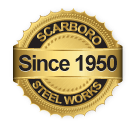Introduction to Structural Steel Beams
Structural steel beams are iconic to modern architecture. Not only do they look great, but steel’s strength makes it a timeless and practical material. There are strict quality standards in place pertaining to steel beam shape, size, composition, and storage practices. The most common types of structural steel beams include the I-beam, L-beam, and T-beam, which come in regular, tapered, and semi-tapered. These shapes are usually achieved by hot or cold rolling but there are others that are made by welding plates, either flat or bent.
A single construction project usually uses different types of materials and different kinds of structural steel beams in order to achieve the desired result. Building materials can consist of structural steel, which is available in many different forms, as well as concrete, wood, clay, and mortar, to name a few. If the structural frame of a building will be utilized for load bearing applications, then structural steel is considered to be the most suitable material for this purpose.
The majority of industrial and commercial buildings are constructed with either structural steel beams or reinforced concrete. During the design process, it is the job of the engineer to identify which of the two (or combination of the two) will be used to achieve the best result possible. There are many things that need to be considered when deciding on what construction material will be used. Factors include availability, weight, fire resistance, strength, sustainability, and constructability.
Structural steel beams and other structural steel products are typically coated with high performance paints which are used to protect the steel surface against environmental hazards such as wind, rain, and other types of extreme weather. This is due to the fact that unfavorable environmental conditions tend to have a negative impact on structures worldwide. Coatings such as epoxy and urethane are widely available and popularly used to fend off the ravages of weather.






